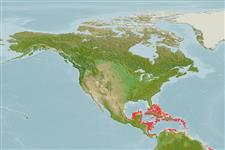Common names from other countries
Issue
Could be a complex of 5 species (Robertson, oral presentation IPFC9, 26 June 2013).
Environment: milieu / climate zone / depth range / distribution range
Ecology
Marine; reef-associated; depth range 8 - 20 m (Ref. 26938). Tropical
Western Atlantic: Cuba (Ref. 26340) and the Bahamas. Also Navassa Island (Ref. 50108).
Size / Weight / Age
Maturity: Lm ? range ? - ? cm
Max length : 3.4 cm TL male/unsexed; (Ref. 5521)
Inhabits coral reefs (Ref. 5521).
Life cycle and mating behavior
Maturities | Reproduction | Spawnings | Egg(s) | Fecundities | Larvae
Böhlke, J.E. and C.C.G. Chaplin, 1993. Fishes of the Bahamas and adjacent tropical waters. 2nd edition. University of Texas Press, Austin. (Ref. 5521)
IUCN Red List Status (Ref. 130435)
CITES (Ref. 128078)
Not Evaluated
Threat to humans
Harmless
Human uses
Tools
Special reports
Download XML
Internet sources
Estimates based on models
Preferred temperature (Ref.
115969): 26.3 - 28.2, mean 27.5 (based on 571 cells).
Phylogenetic diversity index (Ref.
82804): PD
50 = 0.5000 [Uniqueness, from 0.5 = low to 2.0 = high].
Bayesian length-weight: a=0.00490 (0.00196 - 0.01224), b=3.09 (2.87 - 3.31), in cm Total Length, based on LWR estimates for this (Sub)family-body shape (Ref.
93245).
Trophic level (Ref.
69278): 3.3 ±0.4 se; based on size and trophs of closest relatives
Fishing Vulnerability (Ref.
59153): Low vulnerability (10 of 100).
